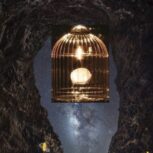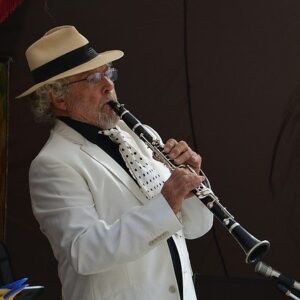
Iris Hanson, originally from Hampshire, is now a Cardiff-based musician. She is an avid plant-keeper, and loves to watch the weather change over the water.
During lockdown, Iris planted the pips from a lemon and now has a grove of sixteen in her flat.
‘The Whistling Cages’ is Iris’ first published story.

Collection of Bones: The Whistling Cages





I had a dream that I was suspended from a cliff edge in one of the old cages. I don’t know how; they could barely support me when I was nine years old. I reasoned that it was a mixture of past and present, as most dreams are. And my lovely sea-view flat can sometimes act as a prison. Anyway, the wind had been roaring and groaning all night. It had probably skipped through my ears using my skull as a whistling cage. I told my friend about that, and she had no clue what I meant so I explained about the cages. I thought everybody knew about them considering they now charge a £12 entry fee. God knows what they spend it on; it’s definitely not knowledgeable guides.
I’m sure I heard one of the guides refer to my Mum’s stories. It was all I could do not to say ‘plagiarist’ pointedly and smother it with dry coughing. I don’t think Mum likes to think of herself as part of the history of anything. She said it made her age a decade every time she glanced in the mirror. I joked that she’d better not look more than twice or she’d be seeing a cage of worm food. Then she gave me the ‘I’m really bored of your immature quips’ look (which lasted for two uncomfortable seconds), sighed, and left the room.
The whistling cages were of gold filigree, embedded between the porous rock pillars. You can find them high in the cliff caves along the Jurassic coast. Mum used to take me up there early on blustery Sunday mornings and tell me about them and that she was related to them through her Jewish ancestry. I’m convinced she had her timelines mixed up, and wasn’t sure how you could be related to geological phenomena, but I always loved her stories, and who was I to correct her.
I’m not entirely clear on the connection because, as I said, I wasn’t entirely convinced at the time, and at the time I was about six. The idea is quite obvious. The cages are there so that when the wind is up, it would whoosh along the tunnels and through the cages, creating beautiful whistling music. Pure enough to calm the souls of the most belligerent pirates, Mum would say. I didn’t imagine they would have much time to lurk and contemplate within the caves, so to my young mind, it was probably not true.
The next cage I found to be significantly more problematic. These golden cages high inside the cliffs were based on the original whistling turtle clarinet used in the premier of Strauss’ Alpine Symphony. It was apparently more of an ocarina really, with the smallest holes played by your little fingers, located on the backs of the turtle’s knees and thighs. This is why the clarinettists must play it, due to their nimble little fingers. Not to say they have small fingers, just that their smallest finger is the most nimble amongst wind players. The cage developed into a highly ornate version with protruding tubes. I suppose that the tubes, over time, became a cage. Well, the bars of the cages were hollow, like a macaroni-spaghetti hybrid. I imagine that’s one way the wind used them.
Mum would sometimes bring along her bass ocarina. She usually wouldn’t play. I assumed at first it was because she was embarrassed. But I think perhaps it was to spite me, because she knew that what I wanted most was to hear her play a duet with the wind in the golden cages. She once told me about her grandfather playing Klezmer on his clarinet, and I suppose that’s her great connection. Exceedingly tenuous at best.
As a small child, I was curious. I always wanted to know how turtles got their nails clipped, but whenever I asked, Mum would stop whatever she was doing, and leave. Once, she threatened to lock me in one of the cages, and leave me there for a week. She said the birds might get in and peck out my eyes. I didn’t think they could, but she assured me she’d found a dead one up here once with its eyes gouged out. It was appendices like these that made her stories a bit less magical. Not the morbidity, just the plain-as-day flawed logic. Who pecked out the bird’s eyes? And how would it know where my eyes were, if it had no eyes? So I asked for clarification. Was I going to be blinded, or was it any bird that dared approach me? I didn’t want to be a bird-blinder. If I was, I couldn’t spend the afternoons with Dad feeding the ducks. So then, she actually did it. She stuffed me into a cage, slammed the gate, and ran down the steps, but not before giving it a kick for good measure. You couldn’t lock them, but it was terribly frightening. I wasn’t allowed to leave that entire day because, as she put it, I wouldn’t stop crying. Which made it sound as if I had a choice.
When I was a few years older, I used to play up there. We’d pretend to swing the cages out over the sea. Below one of them was a deep hole bored through the rock, like the toilet holes in old castles. You could see all the way down to the crashing waves.
I met a composer skulking around amongst the cages once. She said Beethoven would have hated it – too many intertwining melodies. But mostly because he’d never find his way out. Ever since then, I kept an eye out for bones. I found some once, too small to be human. My friend, Nell, said they were from a rat – she would know. But I argued that they had to be the bones of a sightless bird. She said the proof for that was long gone, and that I mustn’t believe my Mum’s stupid stories. I resented her for that.
Iris Hanson